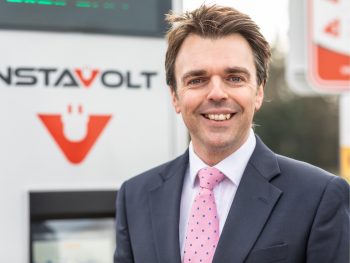Comment: How opening up motorway charging points will speed up EV adoption
Following the news that the Government wants to break the monopoly of Ecotricity electric vehicle chargers at motorways, Adrian Keen, CEO at InstaVolt, comments on why he supports the change and how it will increase EV adoption across the UK.

Adrian Keen, CEO at InstaVolt
Amid a backdrop of rising electric vehicle (EV) sales, accounting for 7% of new car sales last year, the Government has announced its intention to encourage more businesses to install electric charging points at motorway service areas.
Historically, issues of reliability and accessibility to car charging points have been among the key barriers to entry to EVs for both consumers and businesses. It is an issue we feel strongly about and believe must be addressed urgently to ensure the Government’s ban on new petrol and diesel car sales in 2030 is achievable. We are supporting this ambitious plan by scaling up our network which currently stands at 600 chargers across the UK – including our latest site of 15 chargers on the M6 motorway at Welcome Break Corley – with the aim to expand it to 5,000 by 2024/25.
However, until recently, current provider Ecotricity has enjoyed a monopoly on the motorway – possibly the most visible and in-demand charging routes – which has left drivers demanding investment in more and better chargers, which has not been forthcoming.
Following the commencement of a market study by the Competition and Markets Authority, Transport Minister Rachel Maclean has advised on an expansion strategy that will end this monopoly.
What this means for fleet drivers?
In short, the Government plan will oversee the installation of between six and 12 superfast chargers in every motorway service station by 2023, resulting in more than 2,500 nationwide by 2030.
But the wider implications are more far-reaching and long-lasting. By creating a level playing field for car charging network providers at motorways, more market competition will help to increase access to chargers and create more choice including faster and more reliable charging options. As a result, switching to EVs will become a less daunting feat for many businesses.
Challenges remain
Transitioning to an electrified fleet can be a difficult task for businesses. However, there are now EV management tools to help fleet managers make the transition smoother while ensuring optimum business performance. Our flexible Fleet Account Solution offers drivers of participating businesses an extensive, reliable public charging network as well as the reporting tools needed to effectively manage your fleet.
Addressing some of the myths and prejudices surrounding the EV market is also an important step to overcoming these hurdles and ultimately accelerating the switch to EVs and ensuring a seamless and permanent transition. Certainly, increasing the volume and range of electric chargers along the motorway and the strategic road network will help to dispel some of the range anxiety experienced by fleet drivers on long haul travel.
In addition to reliability and accessibility issues to charging points on the motorway, there is also a misconception that EVs cost more than comparable vehicles with internal combustion engines (ICEs). While there is some credence to this argument, much of this stems from legacy perceptions of market leader Tesla whose entry-level cars start at above-average prices of £35k, for example. However, with higher competition as new car manufacturers enter the EV market, prices are being pushed down and second-hand EVs are becoming more available and more affordable. Additionally, the superior efficiency of EVs and the moderate price of electricity would allow fleet operators to quickly recoup the initial outlay. A McKinsey report in the US estimates that fleet EVs can have a total cost of ownership that is 15% to 25% less than that of equivalent ICE vehicles by 2030.
Democratising access to electric charging points can also help to encourage increased EV uptake. Whereas previously some private charging points required payment exclusively on members-only cards paid for with a monthly account subscription fee, drivers can now use the InstaVolt Network, which accepts contactless payment, ensuring fairer access. This more equitable model is being increasingly replicated by other providers in a positive move for the UK’s EV charging network.
The future of EV motorway charging
The Government’s plan to encourage investment in the motorway charging infrastructure is a key milestone in bringing us closer to its 2030 target. I’ve always been a huge supporter of Ecotricity for having the foresight and the conviction to build the first charging network over 10 years ago, but opening up the motorway will be a huge boost to the transition efforts.
However, more needs to be done and can be achieved to reach this ambitious goal. Local authorities have a huge role to play in opening up land for charging infrastructure, and government initiatives such as the Rapid Charging Fund will boost investment further.
Any location has the potential to be an EV charging destination, from your local health centre, or gym to supermarkets and retail outlets. Making charging points ubiquitous and more visible to the public will create important shifts in consumer and business perceptions of EVs. We are committed to supporting this effort by introducing charging points at popular locations for drivers, including 450 chargers at KFC Drive Thru restaurants and the installation of chargers capable of charging up to 125kW at new and existing McDonald’s Drive Thru restaurants.
With increased government investment though comes the risk of increased regulation. The Government has so far laid out clear guidelines of how the money can be spent, but it must not be to the detriment of industry innovation. The Competition and Markets Authority’s intervention on motorways is an important one which will help lead the UK to a greener future for the nation’s fleets faster.

















